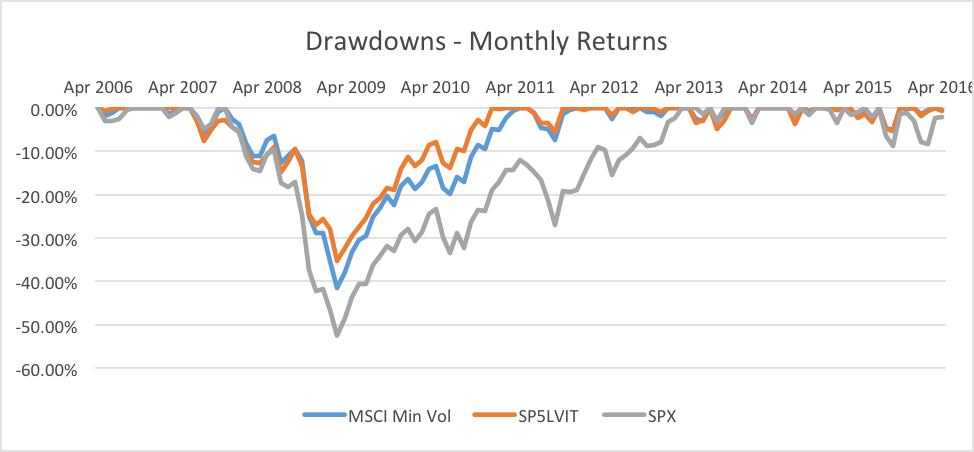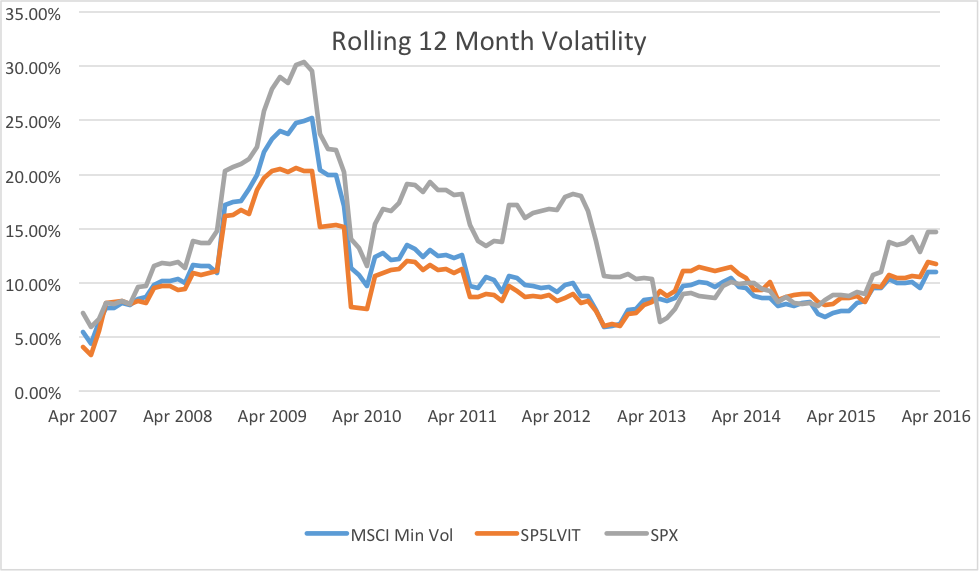Low volatility funds have been hot, hot, hot - the top two domestic based ETFs in the category, USMV and SPLV, now have over $20 billion in assets between them, of which $8 billion has come in during the last six months (40 percent of total AUM).
At first glance, this popularity is understandable: the concept is straightforward and logical, the pitch is compelling and risk-adjusted performance has been strong.
However, neither ETF has gone through a significant market correction, so a real concern is that investors do not have a good grip on the potential downside risk of these strategies. Thankfully, the indexes that both ETFs follow either existed or were backtested (Is a backtest trustworthy? Sometimes! Learn more.) prior to 2008, providing a glimpse of how these strategies should have worked in a past downturn as well as a basis to analyze how they may act in future downturns.
Let's review the general approach of these strategies and then dig into the risk presented in a market downturn.
How the strategy works: Pick the securities with the lowest historical volatility over a stated time period, out of a reference population.
- SPLV selects the 100 stocks with the lowest historical volatility over the last 12 months within the S&P 500 index - the bottom 20 percent quintile. The selection is rebalanced on a quarterly basis.
- USMV employs a similar concept but also takes into account industry concentration, among other factors.
What's the pitch? Outperform in down markets (due to the lower-risk profile) while participating in up markets, using rules-based low volatility indexes. Low volatility is a factor that has been identified by academics as providing superior risk-adjusted returns when compared with the market. So on top of investors receiving a less volatile ride, they should receive good performance to boot!
Given the recent rocky performance of the market coming at the end of a six-year bull run, those are all compelling elements. Here's how USMV pitches themselves, in their own words:
- Exposure to U.S. stocks with potentially less risk
- Historically, minimum volatility strategies have declined less than the market during market downturns
- Seek to minimize the market's peaks and valleys
Performance during the financial crisis: By using historical index data as far back as 2006, which is the furthest point back for which the data is freely available, we are able to analyze how these ETFs would have performed through the financial crisis. Let's take a look:
|
Since 4/28/2006 |
MSCI Min Vol |
SP5LVIT |
SPX |
|
Largest Drawdown: |
-41.59% |
-35.36% |
-52.56% |
|
Max 12-month vol: |
25.26% |
20.58% |
30.42% |
The above table and charts provide a sense of what is possible, and perhaps even expected, in a violent downturn. As can be seen, the loss, while better than the referenced S&P 500, was still pretty dramatic. In actuality, volatility was not "low" at all.
Downside capture was approximately 80 percent for the MSCI minimum volatility index and 70 percent for the S&P low volatility index, resulting in material declines. At their lowest levels, the indexes were down 41.6 percent and 35.4 percent, respectively. Furthermore, volatility spiked well into the 20s.
If I told you in the next downturn we are going to see the S&P down 50 percent again, do we have any idea what these ETFs would be down? The answer is no. While we would expect outperformance, I am not sure it would be as much as investors may expect.
With all this said, I do appreciate low volatility strategies for what they are: a relatively straightforward risk/reward perspective and a lower beta. It is just important that investors understand that while these products have performed well in recent years, they should be prepared for potentially significant losses in another downturn. Could they be less damaging than 2008? Yes. Could they be worse? Certainly.
For those interested in an even more transparent strategy with pre-set risk and reward levels, defined outcomes may be the right choice. In these types of strategies, a tangible floor on losses is provided, allowing for a more defined risk limit - something that may fit well either as a more conservative exposure or useful as a defensive ballast in a portfolio (here's one of my postings on defined outcomes).
So, my gentle warning is beware of the downside exposure in these "low volatility" products. Those who are turning to them for a conservative approach need to understand their limitations to avoid potential disappointment in the inevitable next downturn.
Joe Halpern is the CEO of Exceed Investments. This piece originally appeared on the Exceed Insights blog.



